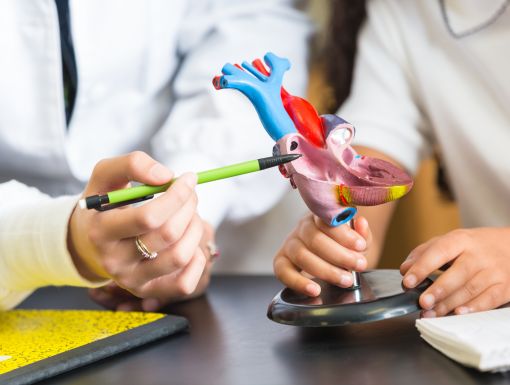
What is Single Ventricle Congenital Heart Disease?
A normal heart has a right and left side with the right side pumping to the lungs and the left side pumping to the body. Single ventricle heart disease is when one side of the heart does not form properly in utero. There are many variations of single ventricle heart disease, with some of the most common forms including hypoplastic left heart syndrome (the left side does not form properly) and tricuspid atresia and/or pulmonary atresia (the right side does not form properly).
Diagnosis
Many single ventricle congenital heart defects are diagnosed in utero, often at the time of the obstetric anatomy ultrasound, which is typically performed at 18-20 weeks gestational age during routine prenatal care. Prenatal diagnosis of congenital heart disease is often in consultation with a maternal fetal medicine physician and a pediatric cardiologist who specializes in fetal diagnosis and management. A prenatal diagnosis allows the family and doctors to prepare for the infant’s delivery and postnatal care.
Some infants are diagnosed with single ventricle heart disease shortly after birth due to low oxygen levels, trouble breathing or poor passage of fluid in the infant’s body. When congenital heart disease is suspected, the diagnosis is confirmed with an echocardiogram.
Treatment
These defects are not able to be “fixed,” meaning that it is not possible to create a part of the heart that is missing or defective. Instead, these defects are “palliated,” usually with a series of three or more surgeries in the first several years of a child’s life. The staged surgeries gradually re-route blood flow and separate the blood flow to the lungs from the blood flow to the body. Often, the first surgery takes place when the infant is only a few days old. Our surgical team, led by Dr. Benjamin Peeler, has extensive experience with neonatal surgery and is at the cutting edge of single ventricle surgical care.
After surgery, infants and children with these defects are cared for by a multidisciplinary team of pediatric cardiothoracic surgeons, pediatric cardiac intensive care and pediatric cardiologists in addition to specialized nurses, therapists and nutritionists. Ochsner Pediatric Cardiology participates in the National Pediatric Cardiology Quality Improvement Collaborative, using many of the protocols developed in scientific studies specifically for care of these complex cases.
Caring for an Infant with Single Ventricle Congenital Heart Disease
Infants with single ventricle congenital heart disease are fragile and require close monitoring by a team of healthcare professionals. Parents are educated on every aspect of care for the infant before going home. After discharge, our Single Ventricle Clinic is a one-stop shop for these infants, with a pediatric cardiology visit, nutritionist, social workers and nurses all focusing on the day-to-day care as well as long-term management of these infants. Our team, along with the Innovation Ochsner team, is developing a smartphone application to help parents and healthcare providers monitor these infants electronically in a format that communicates directly with the patient’s electronic medical record.
For more information on Ochsner’s Congenital Heart Care program, click here.



